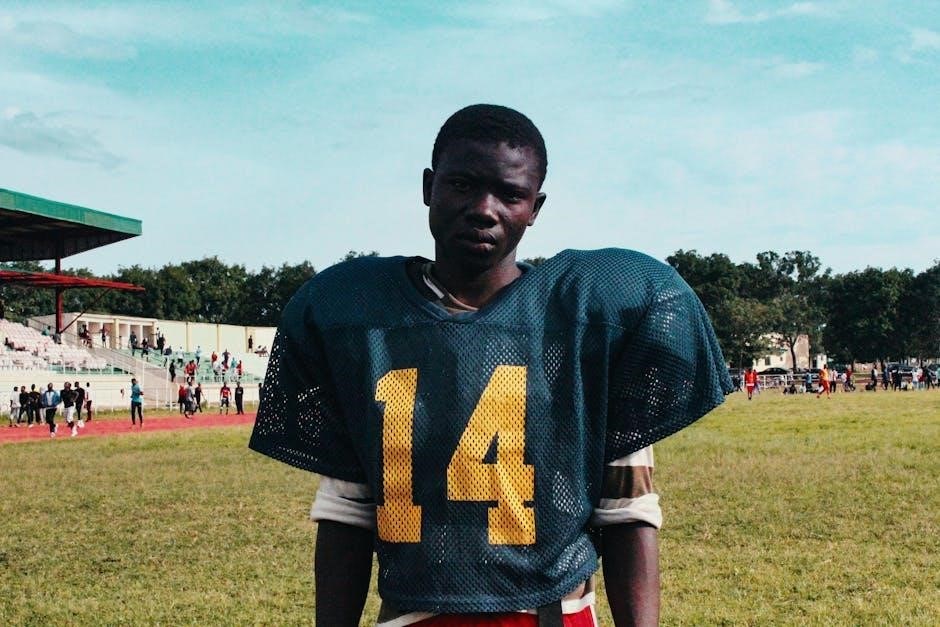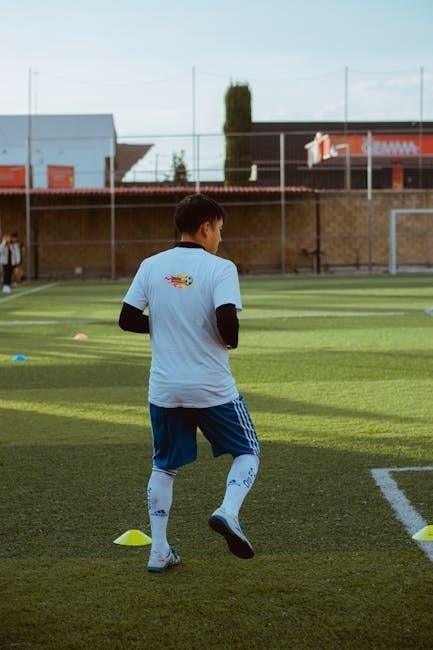D1 college football workout programs are rigorous, structured plans designed to enhance elite athleticism. They blend strength, speed, agility, and conditioning to prepare athletes for peak performance.

Overview of D1 College Football Training
D1 college football training is a comprehensive, science-based approach to developing elite athletes. It integrates strength, speed, agility, and conditioning into a structured program tailored to each player’s role. Training is divided into phases: off-season, in-season, and post-season, ensuring continuous improvement. The focus is on building explosive power, endurance, and flexibility while minimizing injury risk. Programs often include detailed workout schedules, nutrition plans, and recovery strategies. Coaches use data-driven methods to monitor progress, and athletes receive personalized attention to enhance performance. Proper technique and mental preparation are emphasized alongside physical development. Resources like the Texas Football Strength and Conditioning PDF provide insights into designing effective training regimens.

Importance of Structured Workout Programs for Athletes
Structured workout programs are essential for D1 college football athletes to achieve peak performance and reduce injury risks. These programs ensure consistent progress, as they are tailored to address specific needs like strength, speed, and endurance. A well-designed plan helps athletes build explosive power, improve agility, and enhance cardiovascular fitness. Additionally, structured programs foster discipline and accountability, which are critical for competing at the highest level. They also incorporate proper nutrition and recovery strategies, enabling athletes to maintain optimal physical and mental health. By following a structured regimen, players can maximize their potential and prepare effectively for the demands of the sport. Consistency and adherence are key to long-term success.
The Structure of D1 Football Training
D1 football training is divided into distinct phases: off-season, in-season, and post-season. Each phase focuses on building strength, speed, and endurance, ensuring a balanced approach to athlete development.
Phases of the Training Year: Off-Season, In-Season, and Post-Season
D1 football training is structured into three distinct phases: off-season, in-season, and post-season. The off-season focuses on building strength, power, and endurance through rigorous weightlifting and conditioning drills. In-season training prioritizes maintaining fitness levels while preventing injuries, with practices tailored to game strategies. The post-season emphasizes recovery, injury rehabilitation, and analyzing performance for improvement. Each phase is carefully designed to optimize athlete development, ensuring peak performance during competitions and long-term sustainability throughout the year.
Periodization in D1 Football Workouts
Periodization in D1 football workouts involves structuring training into specific cycles to optimize performance and prevent overtraining. Annual plans are divided into phases, with each phase focusing on different goals, such as building strength, enhancing speed, or improving endurance. Monthly and weekly plans further break down these objectives, ensuring a balanced approach to intense training and recovery. This method aligns workouts with the team’s seasonal goals, ensuring athletes peak during critical games. By scientifically planning workload and recovery, periodization helps athletes achieve their best while minimizing injury risks. It’s a cornerstone of D1 training, tailored to the unique demands of football and the fitness profile of elite athletes.

Strength Training in D1 Football Programs
Strength training is a core component of D1 football programs, focusing on building power, explosiveness, and muscle endurance through exercises like squats, bench presses, and deadlifts.
Key Components of Strength Workouts
Strength workouts in D1 football programs emphasize compound exercises like squats, deadlifts, and bench presses to build foundational power. These exercises target multiple muscle groups simultaneously, improving overall athleticism. Additionally, explosive movements such as power cleans and snatches are incorporated to enhance speed and acceleration. A well-structured program also includes lower and upper body splits to ensure balanced development. Periodization is crucial, with phases focusing on hypertrophy, strength, and power. Core and functional training are integrated to improve stability and prevent injuries. Proper form and progressive overload are prioritized to maximize gains while minimizing risk. Recovery strategies, such as active rest and mobility work, are also essential components.
Sample 3-Day Full Body Football Strength Workout
A typical 3-day full body football strength workout is designed to enhance overall athleticism and power. Day 1 focuses on explosive movements: bench press (4 sets of 8 reps), pull-ups (4 sets of 10 reps), and box squats (5 sets of 6 reps). Day 2 emphasizes lower body strength: deadlifts (5 sets of 5 reps), trap bar jumps (4 sets of 8 reps), and Bulgarian split squats (3 sets of 10 reps per leg). Day 3 targets power and speed: clean and press (4 sets of 6 reps), front squats (4 sets of 8 reps), and plyometric exercises like box jumps (5 sets of 10 reps). Core exercises are integrated daily to improve stability.

Speed and Agility Training
Speed and agility training is crucial for D1 football players, focusing on drills that enhance acceleration, deceleration, and directional changes, improving on-field performance and reaction time.
Football-Specific Speed Drills
Football-specific speed drills are tailored to enhance acceleration, deceleration, and agility. These include plyo hurdle drills, ladder exercises, and resisted sprinting using bands or weighted vests. Players perform high knees, butt kicks, and carioca drills to improve flexibility and stride mechanics. Cone drills, such as zigzag runs and shuttle sprints, mimic game scenarios, boosting quick changes of direction. Sprinting uphill or on inclines increases explosive power, while pro agility shuttle tests simulate defensive back movements. These drills are designed to replicate the demands of the game, ensuring athletes develop the speed and agility needed for competitive play at the D1 level. Consistency and proper form are emphasized to maximize results and prevent injury.
Agility Exercises for Quick Changes of Direction
Agility exercises are crucial for football players, focusing on quick directional changes and reaction time. Ladder drills improve foot speed and coordination, while cone drills, such as zigzag runs, enhance sharp cuts and precision. Box drills and shuttle runs simulate game-like scenarios, building explosiveness and rapid acceleration. Plyo hurdle exercises increase flexibility and power, enabling faster transitions. These drills are often performed in structured sets, ensuring players develop the ability to change direction seamlessly. Proper form and consistency are emphasized to maximize effectiveness and reduce injury risk. Agility training is a cornerstone of D1 football programs, preparing athletes for the fast-paced, dynamic nature of the sport.

Conditioning and Endurance
Conditioning and endurance are vital for sustained performance in D1 football. Drills like tempo runs and pro agility shuttles enhance cardiovascular health and muscular stamina, ensuring athletes maintain peak energy levels throughout games.
Conditioning Drills for Football Players
Conditioning drills are essential for building endurance and stamina in D1 football players. Tempo runs, pro agility shuttles, and hill sprints are common exercises to improve cardiovascular health and speed. These drills simulate game-like scenarios, enhancing recovery between plays. Additionally, sled pushes and battle ropes are used to boost explosive power and muscular endurance. Coaches often incorporate interval training to mimic the stop-and-go nature of football, ensuring players maintain energy levels throughout games. Proper execution and progression of these drills are crucial to avoid injury and maximize performance. They are typically integrated into structured programs, tailored to individual and positional needs, to ensure optimal results. These drills are vital for preparing athletes for the physical demands of D1 competition.
Cardiovascular Training Strategies
Cardiovascular training is a cornerstone of D1 football workout programs, enhancing endurance and stamina. Coaches employ high-intensity interval training (HIIT) to improve heart rate recovery and sustain energy levels during games; Distance running and prolonged conditioning drills are also used to build aerobic capacity. Additionally, sport-specific drills like gassers and ladder exercises simulate game scenarios, improving both speed and endurance. These strategies are tailored to individual positions, with linebackers and defensive backs requiring different cardio focuses than linemen. Proper periodization ensures players peak during the season, balancing intensity with recovery to prevent overtraining. Cardiovascular training is seamlessly integrated into the overall program to optimize performance and durability.
Nutrition and Recovery
Proper nutrition and recovery are vital for D1 football athletes, fueling performance and aiding muscle repair. Balanced diets, hydration, and recovery techniques ensure optimal physical readiness and longevity.
Proper Nutrition for Football Athletes
A well-balanced diet is essential for D1 football athletes to optimize performance, recovery, and overall health. Emphasizing lean proteins, complex carbohydrates, and healthy fats fuels muscle growth and energy needs. Hydration is critical, as even mild dehydration can impair physical and mental performance. Athletes should consume meals rich in whole foods, such as chicken, fish, brown rice, and vegetables, while avoiding processed snacks and sugary drinks. Timing meals around workouts and practices ensures proper energy availability and recovery. Additionally, supplements like protein shakes can support muscle repair and growth, but whole foods should remain the primary focus. A personalized nutrition plan helps athletes meet specific goals and maintain peak conditioning throughout the season.
Recovery Techniques to Prevent Injury
Effective recovery is crucial for D1 football athletes to prevent injuries and maintain performance. Techniques include dynamic stretching, foam rolling, and ice baths to reduce muscle soreness and improve flexibility. Compression garments and elevation can enhance blood flow and aid recovery. Proper hydration and sleep are also vital, as they support muscle repair and overall physical restoration. Additionally, incorporating low-intensity activities like light jogging or swimming can promote active recovery without overtaxing the body. These methods help athletes recover efficiently, minimizing the risk of injuries and ensuring they remain ready for intense training and competition.

Mental Preparation and Discipline
Mental preparation is vital for D1 athletes, fostering resilience and focus. Discipline ensures consistency in training, nutrition, and recovery, building the mindset needed for elite performance.
Mental Toughness in Football Training
Mental toughness is a cornerstone of D1 football training, enabling athletes to overcome challenges and maintain composure under pressure. Techniques such as visualization, positive self-talk, and mindfulness are employed to build resilience. Coaches emphasize the development of a growth mindset, encouraging players to embrace adversity as a catalyst for improvement. Proper nutrition and recovery strategies also play a crucial role in sustaining both physical and mental stamina throughout the season. By cultivating mental strength, athletes can perform at their best and contribute effectively to team success, even in high-stakes environments.
Building Discipline Through Consistent Workouts
Consistency is the backbone of D1 football training, fostering discipline that translates to both on-field performance and off-field behavior. Athletes are expected to adhere strictly to structured workout schedules, ensuring they meet both strength and conditioning goals. Coaches instill accountability by setting clear expectations and monitoring progress, which helps players develop a routine and stick to it. Over time, this consistent effort builds mental and physical resilience, preparing athletes for the demands of competitive football. By prioritizing discipline, players not only enhance their skills but also contribute to the overall success of the team, creating a culture of dedication and excellence.
Program Design and Customization
D1 football workout programs are customized to meet specific positional needs and athletic goals, ensuring each player’s development is tailored for optimal performance and longevity in the sport.
Creating a Personalized Workout Plan
Creating a personalized workout plan for D1 college football involves assessing an athlete’s strengths, weaknesses, and positional demands. Coaches use data from performance tests, injury history, and goal setting to tailor programs. The plan integrates strength, speed, agility, and nutrition strategies, ensuring alignment with the athlete’s role on the team. For example, linemen may focus on explosive power, while wide receivers emphasize speed and agility. The plan is adaptable, evolving with the athlete’s progress and seasonal requirements. Regular monitoring and adjustments ensure optimal development and injury prevention, fostering peak performance tailored to each player’s unique needs and aspirations.
Adapting Programs for Different Positions
D1 college football workout programs are tailored to meet the specific demands of each position. Linemen focus on explosive power and strength, while wide receivers prioritize speed and agility. Quarterbacks emphasize accuracy and endurance, and defensive backs concentrate on quick changes of direction. Coaches design workouts to address positional needs, ensuring athletes develop skills relevant to their roles. For instance, offensive linemen may incorporate heavy weightlifting and plyometrics, whereas cornerbacks focus on shuttle drills and reaction training. These specialized approaches maximize performance, minimize injury risks, and align with the team’s strategic goals, ensuring every player is optimized for their unique responsibilities on the field.

Resources and Further Reading
Key resources include PDF guides like Texas Football Strength and Conditioning and Oklahoma Football Nutrition Packet. Visit official college athletic sites or fitness platforms for detailed workout plans.
Where to Find D1 Football Workout Guides
Key resources for D1 football workout guides include official college athletic websites, such as Texas Football Strength and Conditioning PDF and Oklahoma Football Nutrition Packet. Websites like Livestrong and fitness platforms offer detailed strength and conditioning plans. Additionally, many universities publish their training manuals online, providing insights into elite-level preparation. Coaches and athletic departments often share these guides, catering to specific positional needs. For comprehensive programs, search for “D1 football workout program PDF” or visit trusted fitness websites. These resources are invaluable for athletes aiming to meet the rigorous demands of Division 1 football.
Recommended PDF Resources for Football Training
Elite D1 football training can be enhanced with recommended PDF resources like the FB Strength Manual 2020 and Texas Football Strength and Conditioning PDF. These guides provide detailed workout plans, focusing on strength, speed, and agility. Websites such as Livestrong and TeamBuildr also offer comprehensive PDFs tailored for football athletes. The Division 1 Football Fitness Guide is another valuable resource, outlining conditioning and nutrition strategies. Coaches often share their proven training methods in PDF formats, ensuring athletes can access structured programs. These resources are essential for athletes aiming to excel at the highest level, offering a roadmap to achieve peak physical performance and mental toughness.

